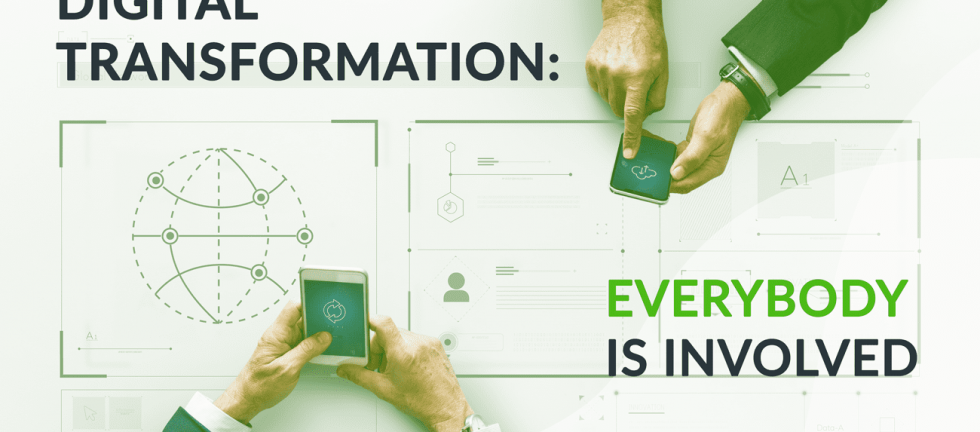Written by Lucia Manetti
Technology is critical in the ability of companies to evolve and keep pace with customers’ expectations. Everyone in the company has a role in the Digital Transformation phenomena: as markets become increasingly competitive, the way organizations work should evolve with them, affecting their organizational structure too.
In this article we seek to cover different aspects of digitalization, answering a well-known question: what is digital transformation and why it is not just a CIO’s, CEO’s and other managers’ affair.
Why everybody in the company is involved in Digital Trasformation?
As James Swason says, in the so-called Digital Transformation:
According to the Guardian, transformation in business takes place due to strong changes in the ecosystem of consumers’ demands, changing technology and increasing competition. Even if it’s impossible to deny the effects of new technologies, evolving business are continually focused on their customers, meaning they value the end users, who are external, par excellence.
On the other hand, the user-centric turning point also involves considering the internal users, the employees from many different perspectives, as they are the first ones who will have access to digital innovations and reap the benefits from them. According to Jane McConnel, when embracing digital transformation, organizations must consider the cultural changes they’ll confront as well, as workers, in all sorts of positions, adjust to adopting and relying on unfamiliar technologies.
In the end, you could adopt great products and technologies, but they are just not enough if they are not followed by a great leadership in the organization and consequently a change/ adaption of its working culture.
Digital Transformation and the market: challenges and opportunities
Being able to understand which are the digital challenges your organization faces is crucial, whatever your market sector is. Here are some quick pieces of advice for different sectors to thrive in an era of digital transformation:
1. DIGITAL TRANSFORMATION IN OSPITALITY MANAGEMENT
- Place the customer at the center of any strategy or operation. What are their needs and how can you meet them?
- Gather and analyze data from analytics platforms in order to optimize campaigns/ targets and content and increase accommodation bookings.
- Elaborate a strategy to face big service aggregators on the the web, like Booking.com
- Study how new platforms have been emerging by listening to customers’ needs and using technology to answer to them (e.g. AiriBnB), and follow suit.
2. DIGITAL TRANSFORMATION FOR E-COMMERCE AND PLATFORMS
- Improve your user’s digital experience
- Optimize the shopping process
- Increase security, keeping users safe from data theft
- Work on customer satisfaction
- Reinforce the portal infrastructure, paying attention to the functionality of the system and its logical resistance in terms of security.
3. DIGITAL TRANSFORMATION IN BANKING
- Deliver a better user experience on online bankings and ATMs
- Boost customer experience
- Overhaul of the organization model, going from a centralized and hierarchical model to a horizontal and more flexible structure. Today’s banks are willing to adopt even more scalable systems and digital platforms, in order to enforce their global and local presence.
- In the last few years, customers start expecting more than banking services. For this reason, the banks started to combine customized offers regarding their core business with other kinds of services, resorting to external partnerships.
- A polishing up of enterprise processes, such as the assessment of departments, is critical in order to better react to a fluid market in constant evolution.
- Banks should redefine their strategies strengthening the role of business models in order to be more innovative and competitive in the current scenario.
4. DIGITAL TRANSFORMATION IN TRAINING
- Resort to online learning tools and facilities
- Provide flexibility, allowing users to learn when and where it suits them
- Make use and incentive the use of online learning communities
- Customize personal development – provide training which can contemplate different objectives and learning styles
- Abandon traditional learning methods which have become unattractive – manuals, lectures, etc.
5. DIGITAL TRANSFORMATION IN HEALTHCARE
- Adopt IT-reliant services to ease the management of health services
- Digitalize the storage and exchange of clinical data
- Adopt digital resources to allow for a quicker Inter-professional communication
- Enhance computer-based support to patients
- Improve the interaction between patients and providers, gathering feedback and use it to get a better experience.
- Fasten service delivery through the digitalization of processes.
- Health promotion using the web and creating a community where people can talk about their needs, getting the right service for them.
- Outpatient care services, taking care of the ones who have been discharged from hospitals or medical centers.
The future is just around the corner
To face these challenges, businesses need to be smart and spot opportunities before they become tipping points. The so-called Digital Transformation is not just a technology revolution, it is part of human history and is changing the way we relate with each other.
We should never forget that letting users live the digital culture is the best way to push for innovation and increase the company’s performance. Therefore, no revolution is possible without the people, also in the digital realm.
Newired is here to help you in this mission: involving people in the digital transformation.


